
Determine the enthalpy of the ATP reaction.
- Subject:
- Chemistry
- Physical Science
- Material Type:
- Activity/Lab
- Provider:
- Carnegie Mellon University
- Provider Set:
- The ChemCollective
- Date Added:
- 02/05/2021

Determine the enthalpy of the ATP reaction.
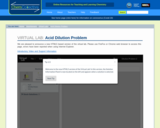
In this activity, students use the virtual lab to create 500mL of 3M HCl solution from a concentrated stock solution of 11.6M HCl. They must first calculate the correct volumes of 11.6M HCl solution and water to mix together to create the final solution. Next, they prepare the solution using the appropriate glassware, and then can check their answer using the concentration viewer in the solution info panel.
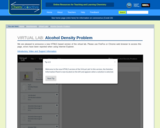
Determine the concentration of an alcohol solution from its density.

In this part of the MRE scenario, students measure the enthalpy of a reaction.
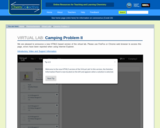
In this part of the MRE scenario, students determine change in the enthalpy of a reaction as the concentration of reactants are varied.
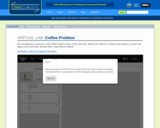
Use the virtual lab to determine how much milk to add to hot coffee to reach the desired temperature
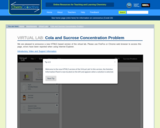
In this activity, students use the virtual lab to prepare a sucrose solution for a soda recipe. They next calculate the concentration of their solution in terms of molarity, percent mass and density.
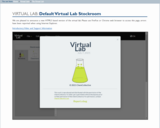
The Virtual Lab is an online simulation of a chemistry lab. It is designed to help students link chemical computations with authentic laboratory chemistry. The lab allows students to select from hundreds of standard reagents (aqueous) and manipulate them in a manner resembling a real lab.
Simulations:
• Default Virtual Lab Stockroom
• Stoichiometry
• Glucose Dilution Problem
• Acid Dilution Problem
• Cola and Sucrose Concentration Problem
• Making Stock Solutions from Solids
• Identifying the Unknown Metal (Metals Density Problem)
• Identifying an Unknown Liquid from its Density
• Alcohol Density Problem
• Gravimetric Determination of Arsenic
• Determining Stoichiometric Coefficients
• Stoichiometry and Solution Preparation Problem
• Textbook Style Limiting Reagents Problems
• Textbook Style Limiting Reagents Problem II
• Predicting DNA Concentration
• Unknown Concentration of DNA Solution Problem
• Thermochemistry
• Camping Problem I
• Camping Problem II
• ATP Reaction (Thermochemistry and Bonding)
• Determining the Heat of Reaction in Aqueous Solution
• Coffee Problem
• Measuring the heat capacity of an engine coolant
• Measuring the heat capacity of an engine coolant II (Advanced version)
• Camping Problem III
• Heats of Reaction - Hess' Law
• Equilibrium
• Cobalt Chloride and LeChatlier’s Principle
• DNA Binding Problem
• Acid-Base Chemistry
• Strong Acid and Base Problems
• Determination of the pH Scale by the Method of Successive Dilutions
• Weak Acid and Base Problems
• Determining the pKa and Concentration Ratio of a Protein in Solution
• Unknown Acid and Base Problem
• Creating a Buffer Solution
• DNA - Dye Binding: Equilibrium and Buffer Solutions
• Determining the pKa and Concentration Ratio of a Protein in Solution
• Standardization of NaOH with a KHP solution: Acid Base Titration
• Solubility
• Determining the Solubility Product
• Temperature and the Solubility of Salts
• Determining the solubility of copper chloride at different temperatures
• Oxidation/Reduction and Electrochemistry
• Exploring Oxidation-Reduction Reactions
• Analytical Chemistry/Lab Techniques
• Standardization of NaOH with a KHP solution: Acid Base Titration
• Unknown Silver Chloride
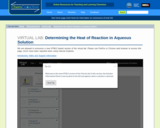
In this activity, students perform an experiment to determine the heat of a reaction.
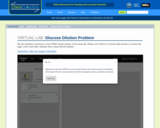
In this activity, students use the virtual lab to create a 0.025M glucose solution from a standard 1M glucose solution. First, they calculate the correct volumes of 1M glucose solution and water to mix together to create the final 0.025M solution. Next, they prepare the solution using the appropriate glassware. Students can check to see if their procedure was correct using the concentration viewer in the solution info panel.
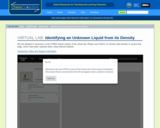
In this activity students use the virtual lab to design an experiment to determine the identity of mislabeled bottles using the densities of the solutions inside.

In this activity, students use the virtual lab to identify an unknown metal by measuring its density and comparing their measurements to the densities of known metals.

In this activity, students use the virtual lab to create stock solutions starting from solid salts. Students must first calculate the correct amount of solid to make the solution. Next, they prepare the solution using the appropriate glassware. Students can check to see if their procedure was correct using the concentration viewer in the solution info panel.
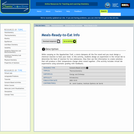
You and a friend are hiking the Appalachian Trail when a storm comes through. You stop to eat, but find that all available firewood is too wet to start a fire. From your Chem 106 class, you remember that heat is given off by some chemical reactions; if you could mix two solutions together to produce an exothermic reaction, you might be able to cook the food you brought along for the hike. Luckily, being the dedicated chemist that you are, you never go anywhere without taking along a couple chemical solutions called X and Y just for times like this. The Virtual Lab contains solutions of compounds X and Y of various concentrations.
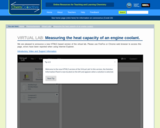
As an analytical chemist at a company developing new engine coolants your task is to determine the heat capacity of a newly developed product and then to determine if its heat capacity is greater of less than that of ethylene glycol.
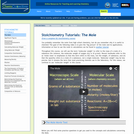
You probably remember the mole from high school chemistry, but do you remember why it is useful to chemists? The goal of the following video is to give the "big picture" of the mole and its applications; information on how to use the mole in calculations can be found in another tutorial. Throughout this course, we will use the term "molecular weight" to refer to the mass of a mole of a substance (for instance, the molecular weight of oxygen (O2) is 32 g/mol). Recent textbooks refer to this as "molar mass" to emphasize (i) that this term refers to the mass, not the weight, of substance, and (ii) that the quantity refers to a mole of a substance, not a single molecule. "Molecular weight" may be less precise, but it remains the term that most practicing chemists use in the laboratory. For this reason, we continue to use "molecular weight" in this course.
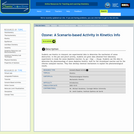
During the first kinetics lecture, we traced the efforts of atmospheric chemists to explain the depletion of ozone in the upper atmosphere. (The powerpoint slides have been posted on Blackboard for your review.) U2 spy planes gathered much of the initial data that linked ClO in the stratosphere to the ozone depletion. The data collected during these flights showed the concentrations of various chemical species in the stratosphere, but did not measure how fast the processes were occurring. To determine the kinetics (rates) of ozone depletion reactions, chemists perform controlled laboratory studies. In this homework, we will interpret data obtained from such laboratory experiments to study the ozone depletion reaction.